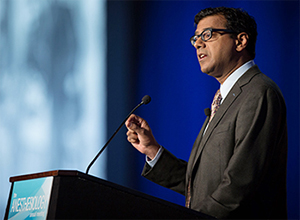
Atul Gawande, M.D.: ‘What we are working for is pretty simple. It’s the right care at the right time every time.’
Anesthesia and sterile environments are seen as the first two foundations of improved outcomes in surgery, but teamwork is establishing itself as an equally important part of that foundation. Atul Gawande, M.D., explained that vision Saturday during his ANESTHESIOLOGY 2017 Keynote Address.
“We found out there are three major killers we had to focus on —unsafe anesthesia, unsafe infection … and a third category, lack of teamwork,” said Dr. Gawande, a renowned advocate in improving patient safety and surgical outcomes. “Activate every voice in the room.”
Dr. Gawande is Executive Director of Ariadne Labs and Professor in the Department of Health Policy and Management at the Harvard T.H. Chan School of Public Health and Samuel O. Thier Professor of Surgery at Harvard Medical School. He also is the founder of Lifebox, a global nonprofit organization devoted to eradicating some of the world’s deadliest surgical conditions.
Anesthesiologists have served as leaders in developing the teamwork approach in the operating room, he said. That has led to the development of checklists to improve the performance of surgical teams
“Anesthesiologists thinking systematically about what we can do in surgery is incredibly inspiring to me. You took your field from having deaths that could occur on a regular basis to perfectly healthy people,” Dr. Gawande said.
The challenge is to get more people around the world to buy into the concept of teamwork because medical professionals are not trained to work as a team. The World Health Organization’s Safe Surgery Saves Lives Program was launched to develop checklists and expand their adoption. A related study at eight cities around the world demonstrated how effective teamwork is.
“What we found was that complications fell by half in every hospital that had adopted the program. The reduction in deaths was 47 percent. It was extraordinary. It was a sign that thinking about ourselves as a system would be transformative,” he said.
Further studies in South Carolina are showing similar advances in outcomes, but the success of adopting checklists varies according to their implementation. Canada simply mandated implementation, which did not improve outcomes.
“Other countries rolled the checklists out as a leadership commitment, not a mandate, and had regular feedback, treating it as a culture change,” Dr. Gawande said. As a result surgical deaths fell 43 percent in Norway, 35 percent in France and 26 percent in Scotland.
A new development is a manual of checklists for crisis events. The checklists have been designed to be easy to read. An Emergency Manuals Implementation Collaborative and other studies, including one at Stanford University, are looking for even better methods of implementation.
However, improved surgical outcomes depend on more than just teamwork and systems, Dr. Gawande said. He explored the importance of determining which outcomes matter the most. Talking with the patient and families about treatment options is vital, and he used a case to illustrate the point.
An elderly woman with dementia was severely burned while smoking in bed. After talking to her family, health care professionals treated her burns and she was on the road to recovery at three weeks. When her family realized she would need a tracheostomy and a feeding tube for the remainder of her life, they rejected that treatment. The patient died 24 hours after extubation, he said.
A study of stage IV lung cancer patients randomized the terminally ill patients to usual oncology care or palliative care. Study results showed that the number of patients in the early palliative care group who were still receiving chemotherapy two months before death was half of those receiving usual care, Dr. Gawande said.
“Overall measures of suffering, anxiety and depression were down in the group that got early palliative care,” he said. “They spent less time in the hospital and in the ICU, with 30 percent lower overall costs. They started hospice sooner and had more time at home.
“Here was the kicker. They lived 25 percent longer.”
The lesson, he said, is to talk to patients and families about how they want to live versus just working to prolong their lives.
Dr. Gawande thanked physician anesthesiologists for their decades of work in leading the way to improve patient safety, saying, “What we are working for is pretty simple. It’s the right care at the right time every time.”
Return to Archive Index